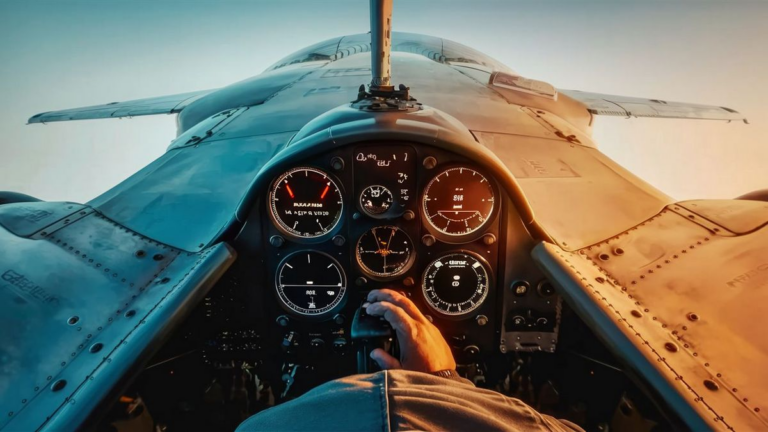An aircraft stall is a critical aerodynamic condition that occurs when the angle of attack of an aircraft’s wing exceeds the critical angle, leading to a sudden decrease in lift and an increase in drag. This phenomenon is crucial for pilots to understand and manage, as it can have severe consequences if not handled correctly.
Understanding the Aerodynamics of a Stall
To comprehend an aircraft stall fully, it’s essential to delve into the aerodynamics involved. Lift, the force that keeps an aircraft airborne, is generated by the airflow over the wings. This lift is directly proportional to the angle of attack—the angle between the chord line of the wing and the relative wind.
As the angle of attack increases, the lift also increases up to a certain point. However, beyond a critical angle, the airflow over the wing becomes turbulent, causing separation of airflow and a sudden drop in lift. This critical angle varies depending on the aircraft’s design and configuration.
Types of Stalls
There are several types of stalls that can occur depending on the flight conditions and configuration of the aircraft:
- Power-Off Stall: This type of stall occurs when the aircraft is at low airspeed with the engine power reduced or idle, such as during the landing phase.
- Power-On Stall: Also known as a departure stall, this type happens when the aircraft is at high power settings, such as during takeoff or during a go-around maneuver.
- Cross-Control Stall: This type of stall occurs when the aircraft is in a slipping or skidding turn, with adverse yaw causing one wing to stall before the other.
Recognizing and Recovering from a Stall
It’s crucial for pilots to recognize the early signs of an impending stall to prevent it from developing into a full stall. Common indicators include sluggish controls, buffeting sensations, and the stall warning system activation.
If an aircraft does enter a stall condition, prompt and correct recovery procedures are vital. These typically involve reducing the angle of attack by lowering the nose of the aircraft, applying full power if necessary, and regaining control of the aircraft’s attitude and airspeed.
Training and Simulation
Pilots undergo extensive training to understand the dynamics of stalls and to practice recovery procedures in a controlled environment. Simulator sessions and flight training exercises focus on stall recognition, prevention, and recovery to ensure pilots can effectively handle these critical situations.
An aircraft stall is a complex aerodynamic event that pilots must be prepared to manage safely. Understanding the causes, types, and recovery techniques associated with stalls is essential for maintaining flight safety and ensuring optimal aircraft performance.
Frequently Asked Questions
Here are some frequently asked questions related to aircraft stalls:
| Question | Answer |
|---|---|
| What is the critical angle of attack? | The critical angle of attack is the angle at which airflow over the wing becomes turbulent, leading to a sudden decrease in lift. |
| How do pilots recognize an impending stall? | Pilots can recognize an impending stall through various indicators such as sluggish controls, buffeting sensations, and activation of the stall warning system. |
| What are some recovery procedures for a stall? | Recovery procedures for a stall typically involve reducing the angle of attack, applying full power if necessary, and regaining control of the aircraft’s attitude and airspeed. |
| Why is understanding stalls crucial for pilots? | Understanding stalls is crucial for pilots as it enables them to effectively manage critical aerodynamic events, ensuring flight safety and optimal aircraft performance. |
Common Misconceptions about Stalls
Despite the importance of understanding stalls, there are some common misconceptions surrounding this aerodynamic phenomenon:
- Stalls only occur at low speeds: While stalls often occur at low airspeeds, they can also happen at higher speeds under certain conditions, such as during aggressive maneuvering.
- Stall recovery always requires applying full power: While applying full power can help in some stall recovery scenarios, it’s not always necessary or recommended, depending on the specific situation.
- Stalls are always caused by pilot error: While pilot error can contribute to stalls, other factors such as weather conditions, aircraft configuration, and mechanical issues can also play a significant role.
Advanced Stall Characteristics
In addition to the basic types of stalls mentioned earlier, there are some advanced stall characteristics that pilots should be aware of:
- Deep Stall: A deep stall occurs when the airflow over the wing is disrupted to the extent that the elevators lose effectiveness, making recovery challenging.
- Accelerated Stall: An accelerated stall occurs when the aircraft is subjected to excessive G-forces, causing the angle of attack to exceed the critical angle despite maintaining airspeed.
See also:






